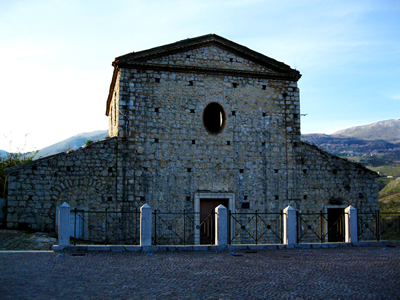 Fino ai primi dell’800, i corpi della gente povera non venivano sepolti in una bara, ma gettati in una stanza degli ipogei della cattedrale. Nel 1807, in seguito all’Editto di Saint Cloud del 1806, venne costruito il cimitero di San Giuseppe. In principio erano solo mura poco innalzate, con aperture in corrispondenza delle tre vasche pendenti verso il burrone, contenute all’ interno dei supporti murari. La struttura era predisposta in maniera tale da garantire la discesa dei cadaveri una volta accumulati. Nel 1865 venne inaugurato l’attuale cimitero, su pressione di alcuni bersaglieri che, giunti in paese per combattere il brigantaggio, soggiornavano in una zona del Palazzo Vescovile e non tolleravano il cattivo odore che si diffondeva nell’aria. Le botole furono pertanto chiuse con un’abbondante gettata di calce viva. Sul finire dell’800 il vescovo Capone fece edificare la chiesa di San Giuseppe sul vecchio cimitero, in pietra, con timpano e rosone; sono ancora visibili all’interno le botole e le stanze dove ricadevano i corpi.
Fino ai primi dell’800, i corpi della gente povera non venivano sepolti in una bara, ma gettati in una stanza degli ipogei della cattedrale. Nel 1807, in seguito all’Editto di Saint Cloud del 1806, venne costruito il cimitero di San Giuseppe. In principio erano solo mura poco innalzate, con aperture in corrispondenza delle tre vasche pendenti verso il burrone, contenute all’ interno dei supporti murari. La struttura era predisposta in maniera tale da garantire la discesa dei cadaveri una volta accumulati. Nel 1865 venne inaugurato l’attuale cimitero, su pressione di alcuni bersaglieri che, giunti in paese per combattere il brigantaggio, soggiornavano in una zona del Palazzo Vescovile e non tolleravano il cattivo odore che si diffondeva nell’aria. Le botole furono pertanto chiuse con un’abbondante gettata di calce viva. Sul finire dell’800 il vescovo Capone fece edificare la chiesa di San Giuseppe sul vecchio cimitero, in pietra, con timpano e rosone; sono ancora visibili all’interno le botole e le stanze dove ricadevano i corpi.
 Until the beginning of the nineteenth century, common people’s bodies were not buried in a coffin, but instead they were gathered in the basement of the Cathedral. In 1807, after the Edict of Saint Cloud of 1806, was built the “Cemetery of S. Giuseppe”. At the beginning, there were only short walls which contained tanks leaning towards the ravine. This structure was able to let fall down the bodies at the opening. In 1865 the cemetery, as it is today, was inaugurated. It was opened at the request of some soldiers who were in town to fight the brigandage. They lodged in the Bishop’s Palace and complained about the smell. Therefore, the trap doors were closed with plentiful stratum of lime. At the end of the century the bishop Capone built the church of “San Giuseppe” on the ancient cemetery, in stone, with tympanum and rose window. The trapdoors and the rooms where the bodies fell are still visible on the inside.
Until the beginning of the nineteenth century, common people’s bodies were not buried in a coffin, but instead they were gathered in the basement of the Cathedral. In 1807, after the Edict of Saint Cloud of 1806, was built the “Cemetery of S. Giuseppe”. At the beginning, there were only short walls which contained tanks leaning towards the ravine. This structure was able to let fall down the bodies at the opening. In 1865 the cemetery, as it is today, was inaugurated. It was opened at the request of some soldiers who were in town to fight the brigandage. They lodged in the Bishop’s Palace and complained about the smell. Therefore, the trap doors were closed with plentiful stratum of lime. At the end of the century the bishop Capone built the church of “San Giuseppe” on the ancient cemetery, in stone, with tympanum and rose window. The trapdoors and the rooms where the bodies fell are still visible on the inside.
